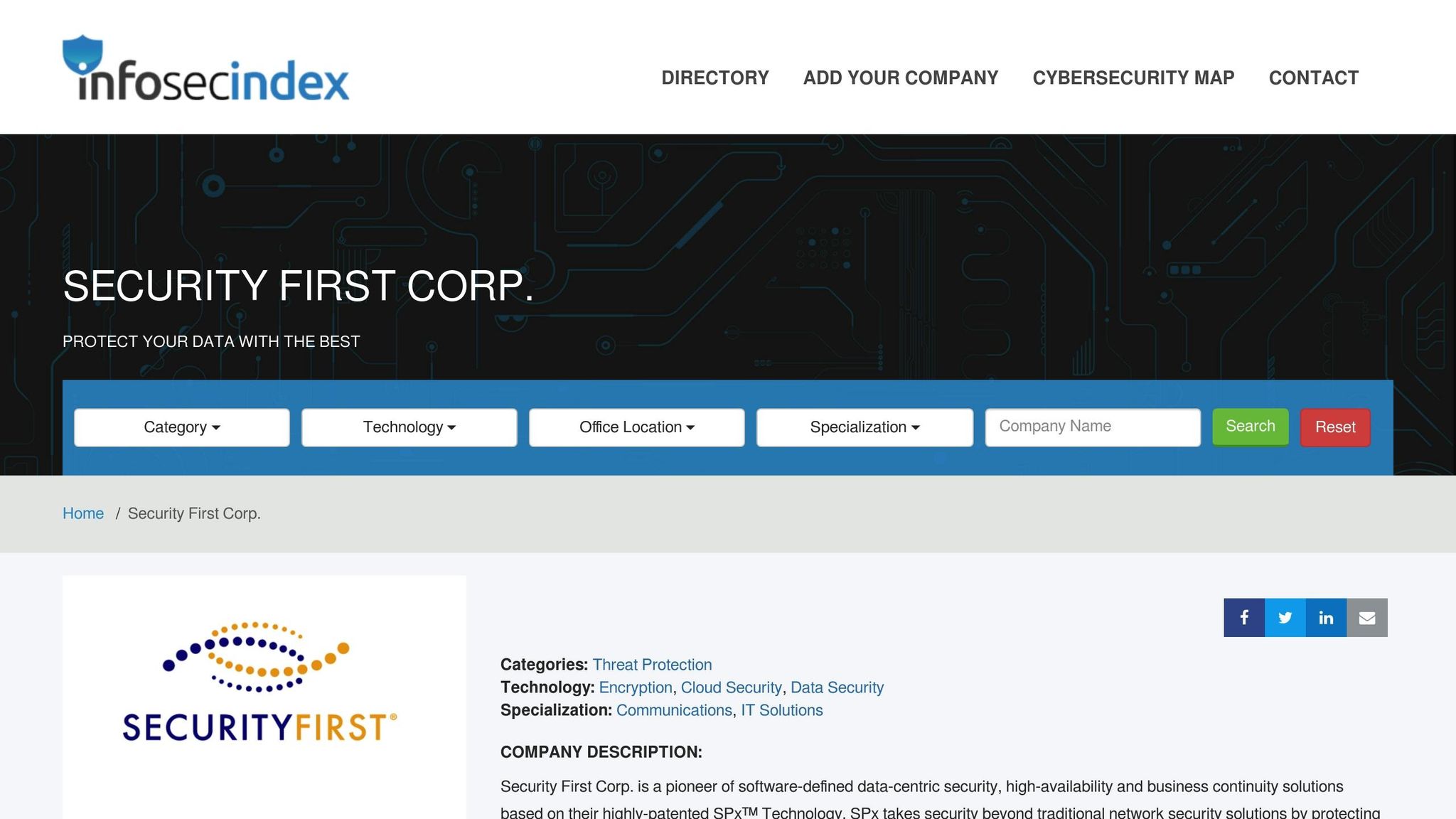Small businesses face a variety of risks - from data breaches to compliance violations - that can lead to financial losses and operational setbacks. Choosing the right risk assessment tool can help you identify, prioritize, and manage these risks effectively.
Key Takeaways:
- Understand Your Risks: Identify specific risks based on your industry and business size (e.g., cybersecurity for tech startups, compliance for healthcare).
- Align Tools with Goals: Match tools to your priorities, whether it’s scaling, entering new markets, or improving compliance.
- Evaluate Features: Look for essential capabilities like risk identification, impact analysis, mitigation planning, and real-time monitoring.
- Consider Usability: Choose tools that are easy to use, scalable, and integrate well with your existing systems.
- Test Before Committing: Use demos or trials to ensure the tool fits your needs and involves relevant stakeholders in the decision-making process.
Quick Comparison:
| Criteria | Small Businesses (10-50 employees) | Larger Enterprises |
|---|---|---|
| Tool Type | All-in-one, easy-to-use platforms | Customizable, robust solutions |
| Key Risks | Data breaches, client disputes, compliance | Data governance, brand safety, continuity |
| Budget | Low to moderate | Higher, with dedicated IT support |
| Features Needed | Basic risk matrices, integration with existing tools | Advanced AI-powered monitoring, custom features |
By focusing on your business’s unique risk profile and operational needs, you can select a tool that helps prevent disruptions and supports smarter decision-making.
What Are The Risk Assessment Tools? - SecurityFirstCorp.com

Identify Your Business Risk Assessment Requirements
Every business faces its own set of risks, shaped by its size, industry, and goals. A tech startup, for instance, encounters challenges that are worlds apart from those faced by a manufacturing company or a law firm. The first step? Pinpoint the risks specific to your business and prioritize them to focus your mitigation efforts.
The nature of your business dictates which risks demand immediate attention. A solo consultant running an online business might be most concerned with data breaches or client disputes. On the other hand, a manufacturing company with 50 employees has to think about workplace safety, supply chain disruptions, and staying compliant with regulations.
Find Your Main Risk Areas
Start by examining four key risk categories: cybersecurity, compliance, operational continuity, and health & safety. The weight you assign to each depends entirely on your industry and business model.
- Financial services face challenges like ensuring data accuracy and meeting strict regulatory requirements. These businesses need tools that can analyze and verify financial data to minimize risks like fraud or costly compliance errors.
-
Legal professionals have their own unique pressures. Platforms that streamline legal research and automate workflows help manage compliance and improve efficiency.
DeepJudge, an AI-powered legal search and workflow automation tool, supports law firms by optimizing access to internal knowledge and improving management of compliance and legal precedents.
-
Creative professionals must navigate risks tied to brand safety and content compliance.
Jacquard, an AI-driven messaging optimization platform, helps brands create consistent, compliant, and engaging content at scale across various channels.
-
For businesses handling sensitive customer data, privacy regulations add an extra layer of complexity.
Tonic.ai addresses these concerns by offering AI-powered synthetic data generation. This allows businesses to create realistic, privacy-compliant datasets that align with GDPR and CCPA standards while protecting sensitive information.
- E-commerce businesses are often focused on minimizing risks related to customer engagement and conversions, while biotech companies need to safeguard intellectual property and manage R&D risks.
Rather than trying to tackle every possible risk at once, zero in on the vulnerabilities that could cause the most harm to your operations or reputation. Prioritization is key.
Match Risk Management Goals with Business Objectives
Your risk management strategy should align with your broader business goals. For example, if rapid scaling is on your horizon, you'll need tools that can grow alongside you. If you're targeting new markets, compliance and regulatory risks should be at the forefront.
Tailoring risk management tools to your business size and resources is equally important:
- Small businesses often benefit from all-in-one tools that are easy to use and cover a broad range of basic operational risks. Businesses with 10-50 employees might find integrated platforms - combining CRM, online presence management, and scheduling - especially helpful for addressing foundational risks tied to operations and customer relationships.
- Enterprises and large businesses require more robust solutions. These might include custom features, implementation support, flexible deployment options, and expert guidance. Their risk priorities often involve complex areas like data governance, brand safety, and large-scale operational continuity.
Resource availability also plays a role. A company with a dedicated IT team can handle advanced cybersecurity assessments, while one without technical expertise needs straightforward tools that anyone can operate.
Finally, consider your growth plans. If you’re aiming for international expansion in the next two years, you’ll need tools capable of assessing compliance risks across various jurisdictions. If your focus is adding new product lines locally, operational and quality control risks take precedence.
Key Features to Check When Reviewing Risk Assessment Tools
When evaluating risk assessment tools, it's essential to focus on features that align with your business needs. Choosing the wrong platform can leave you vulnerable or burden your team with unnecessary complexity. To make an informed decision, pay attention to three crucial areas.
Main Functions and Capabilities
The effectiveness of any risk assessment tool starts with its core functions. Look for platforms that provide risk identification, impact analysis, mitigation planning, and real-time monitoring - these elements create a well-rounded risk management system.
- Risk identification: A good tool helps you detect potential threats early. Automated scanning and data analysis are especially useful for uncovering risks across your operations.
- Impact analysis: Understand the potential consequences of each risk, such as financial losses, damage to reputation, or resource strain.
- Mitigation planning: Tools should guide you in creating actionable strategies. Templates, workflows, and collaboration features can simplify the process of developing and implementing responses.
- Real-time monitoring: Stay informed about shifting risk levels so you can adapt your strategies as situations evolve.
Once the core functions are in place, evaluate whether the tool's design and integration capabilities align with your operational workflow.
User-Friendliness, Growth Potential, and System Integration
Even the most powerful tool is useless if your team can't navigate it. Prioritize platforms with an intuitive interface that allows employees to update risk assessments, generate reports, and manage workflows without requiring constant technical assistance.
Scalability is another critical factor. Your business needs today may not be the same in a few years. Opt for tools that offer flexible pricing, additional user licenses, and expanded features to support your growth.
Integration with your existing software ecosystem is equally important. The tool should work seamlessly with systems like your CRM, accounting software, project management tools, and communication platforms. Poor integration can result in data silos, duplicated tasks, and overlooked risks.
- Data import/export: Ensure the tool allows easy data transfer between systems.
- API access and pre-built integrations: These features can save time and simplify implementation.
Compliance Support and Reporting Options
Compliance and reporting are non-negotiable aspects of risk management. Depending on your industry, you may need to meet regulations like OSHA safety standards, HIPAA privacy rules, or other sector-specific requirements. A good tool will include built-in compliance frameworks and automated reporting features tailored to these standards.
For US-based businesses, select tools that support customizable reports in formats like MM/DD/YYYY, USD currency, and imperial measurement units. This ensures reports are accurate and ready for submission without extra manual adjustments.
Advanced reporting features are also key. Look for platforms with customizable dashboards, automated scheduling, and multi-format export options. These capabilities allow you to generate everything from executive summaries to detailed compliance reports, ensuring consistency across all levels of communication.
Stability AI, for example, offers enterprise solutions with compliance support for deploying their multimodal media generation and editing tools.
sbb-itb-bec6a7e
Risk Assessment Tools for Small Businesses
Once you've identified key risk areas, the next step is selecting the right tools to manage them. Small businesses have a variety of options, ranging from straightforward frameworks to advanced AI platforms. The best choice depends on your budget, expertise, and the complexity of your risk profile.
Here’s a closer look at how basic tools and AI-powered solutions can meet your risk management needs.
Basic Tools: SWOT Analysis and Risk Matrix
For small businesses just starting out, simple methods like SWOT analysis and risk matrix tools provide an excellent starting point. These tools are cost-effective, easy to use, and require little to no specialized training - perfect for teams with limited resources.
- SWOT Analysis: This tool helps identify your business's strengths, weaknesses, opportunities, and threats. It’s easy to execute using basic spreadsheet software and is particularly effective during strategic planning or routine business reviews.
- Risk Matrix: Building on the insights from a SWOT analysis, a risk matrix allows you to prioritize risks based on their likelihood and potential impact. By plotting risks on a simple grid, you can quickly identify which issues need immediate attention and develop mitigation strategies.
Both tools are affordable and straightforward, enabling small teams to adopt structured risk assessment practices without significant upfront investment.
AI-Powered Tools for Advanced Risk Management
As your business grows and risks become more complex, AI-powered tools can provide deeper insights and automated monitoring capabilities. These platforms use machine learning to analyze data, predict threats, and recommend mitigation strategies - all in real time.
For instance:
- Cybersecurity Tools: AI-driven platforms can monitor network activity, detect unusual behavior, and automatically respond to potential threats.
- Financial Risk Assessment: AI tools can analyze cash flow trends, market fluctuations, and customer payment patterns to flag emerging financial risks.
Small businesses can explore AI-powered solutions through platforms like AI for Businesses, which offers a curated directory of tools tailored for SMEs. Options include tools like Looka, Rezi, Stability.ai, and Writesonic, which can enhance various aspects of your operations.
One of the standout benefits of advanced tools is their ability to process large volumes of data continuously. Unlike human analysts who might review reports periodically, AI systems monitor key indicators daily, providing timely alerts before risks escalate. This kind of proactive monitoring complements basic assessments, offering the scalability needed as your business faces more challenges.
Keep in mind, however, that these advanced solutions often come with higher costs. Pricing typically depends on the features you select and the size of your business, so it’s important to evaluate your specific needs before investing.
Step-by-Step Tool Selection Checklist
Choosing the right tool for your business can feel overwhelming, but breaking it into clear steps makes the process more manageable. Here’s a straightforward checklist to guide you, ensuring your choice aligns with both your business goals and budget.
Set Business Goals and Risk Priorities
Start by defining what you want to achieve. Are you aiming to address cybersecurity threats, monitor financial risks, or ensure compliance with industry regulations? Your main objective will help pinpoint the features you need the most.
Take a close look at your business operations to rank your key risks. For instance, a small e-commerce company might focus on securing payment processes, protecting customer data, and minimizing supply chain disruptions. On the other hand, a consulting firm might prioritize managing client contract risks, professional liability, and preventing data breaches.
Establish a timeline and budget, factoring in all costs, such as setup, training, and integration. Also, document any compliance requirements early on. Regulations vary by industry - healthcare businesses may need HIPAA compliance, while financial institutions often adhere to SOX or PCI DSS standards.
Compare Tools Using Key Criteria
Once your goals are clear, compare tools based on factors that directly impact your operations.
- Functionality: Check if the tool addresses your top risks. Look for features such as automated monitoring, customizable risk matrices, integration with existing software, real-time alerts, and detailed reporting.
- Cost: Go beyond the subscription fee. Consider setup, training, and integration costs to calculate the total cost of ownership.
- Ease of Use: A tool that’s easy to navigate can save training time and ensure your team adopts it quickly. Look for features like drag-and-drop interfaces and simple navigation.
- Integration: Ensure the tool works seamlessly with your existing systems, such as your CRM or accounting software, to maintain consistency and efficiency.
Here’s an example of how you might evaluate tools using a scoring matrix:
| Evaluation Criteria | Weight | Tool A Score | Tool B Score | Tool C Score |
|---|---|---|---|---|
| Functionality | 30% | 8/10 | 7/10 | 9/10 |
| Cost-effectiveness | 25% | 6/10 | 9/10 | 7/10 |
| Ease of use | 20% | 9/10 | 8/10 | 6/10 |
| Integration | 15% | 7/10 | 6/10 | 8/10 |
| Support quality | 10% | 8/10 | 7/10 | 9/10 |
Also, prioritize tools that provide strong support and compliance features. Vendors offering expert support, indemnification, and built-in compliance tools will help ensure the solution remains secure and grows with your business.
Test and Set Up Your Chosen Tool
Before making a final decision, request a demo or free trial to test the tool in your actual business environment. This step ensures the tool aligns with your earlier criteria.
Involve stakeholders from different departments during testing. Include both daily users and decision-makers who depend on the tool’s reports. For example, IT can verify integration capabilities, while department heads can review how well the reporting meets their needs.
Use real business data during testing to check how effectively the tool identifies and prioritizes risks. Confirm that its outputs are actionable and align with your brand’s standards.
Plan for comprehensive staff training to ensure a smooth rollout. Even tools with intuitive interfaces require onboarding to maximize their potential. Training should cover basic functionality, reporting, and troubleshooting.
Finally, configure the tool to reflect your organization’s specific needs - set risk categories, notification preferences, and user permissions. This ensures the tool is tailored to your structure and delivers clear, actionable insights that support your goals.
Conclusion: Selecting the Right Tool for Your Business
Picking the right risk management tool is all about aligning it with your business goals and focusing on what truly matters - functionality over flashy features. Start by defining your top risk priorities, whether it’s tackling cybersecurity threats, reducing financial risks, or ensuring compliance. Then, evaluate tools based on their features, cost, ease of use, and ability to integrate with your current systems. This ties back to the checklist we discussed earlier.
Your chosen tool should grow alongside your business. Look for options that offer flexibility, like self-hosting, API integration, or cloud-based services, so you can adapt as your needs evolve. Tools that allow custom workflows and integrate seamlessly with your existing setup will ensure your risk management strategy stays relevant and effective.
Real-world examples show how the right tool can drive results:
In September 2025, Mercado Libre, Latin America's largest e-commerce marketplace, used Stability AI tools to enhance product visuals, leading to a 25% increase in click-through rates.
For smaller businesses aiming to stay up-to-date, platforms like AI for Businesses provide a curated list of AI-powered tools designed to automate processes and simplify workflows. This approach makes it easier to explore and adopt specialized solutions as your risk landscape changes, without being stuck with outdated methods.
But selecting the tool is just the beginning. Long-term success depends on ongoing support and maintenance. Enterprise-grade solutions often come with expert guidance, compliance features, and robust support systems. To keep your risk management strategy effective, plan for regular training sessions, tool reviews, and updates.
Investing in the right risk assessment tool today can lead to better decision-making, fewer disruptions, and stronger compliance down the road. Take the time to test potential tools, involve your team in the decision-making process, and choose a solution that offers the flexibility and support your business needs to navigate today’s complex risk environment. By tying these final steps back to your initial risk priorities, you’ll build a strategy that’s both comprehensive and adaptable.
FAQs
What steps can small businesses take to choose a risk assessment tool that fits their industry and goals?
To select a risk assessment tool that aligns with your industry and objectives, begin by pinpointing the specific risks and challenges your business encounters. Think about things like regulatory demands, your operational workflows, and any vulnerabilities unique to your sector.
Focus on tools that provide features designed for your needs. These might include customizable templates, real-time reporting capabilities, or compliance checks tailored to your industry. It's also smart to choose tools that are easy to use and can scale as your business grows. Taking the time to align the tool's features with your goals can lead to a better fit and deliver value over the long haul.
How do risk assessment tools for small businesses differ from those designed for larger enterprises, and what does this mean for their effectiveness?
Risk assessment tools tailored for small businesses are often straightforward, budget-friendly, and designed to tackle the unique hurdles smaller organizations face - like limited resources or smaller teams. These tools emphasize simplicity and quick setup, making them a great fit for business owners who may not have a dedicated risk management team on hand.
On the other hand, tools designed for larger enterprises tend to be more intricate. They often come with advanced capabilities like extensive data integration, scalability, and custom reporting to handle more complex and widespread risks. While these features are powerful, they might feel excessive or impractical for smaller businesses. Selecting the right tool ensures your business gets the necessary support without adding unnecessary complexity or straining financial resources.
Why should stakeholders be involved in choosing a risk assessment tool, and how can this be done effectively?
Involving stakeholders in choosing a risk assessment tool is a smart move. It helps ensure the tool not only aligns with your business goals but also meets the unique needs of different teams. Stakeholders often have valuable knowledge about specific risks, workflows, and operational challenges, which can guide the selection process toward practical and efficient solutions.
To make this work, start by identifying key players - think department heads or team leads - and gather their feedback on pain points and priorities. Host collaborative sessions, like discussions or workshops, to evaluate options together. You might also find it helpful to create a checklist to compare tools based on features, ease of use, and costs. This inclusive method not only builds support for the decision but also helps the tool integrate smoothly into your existing processes.


